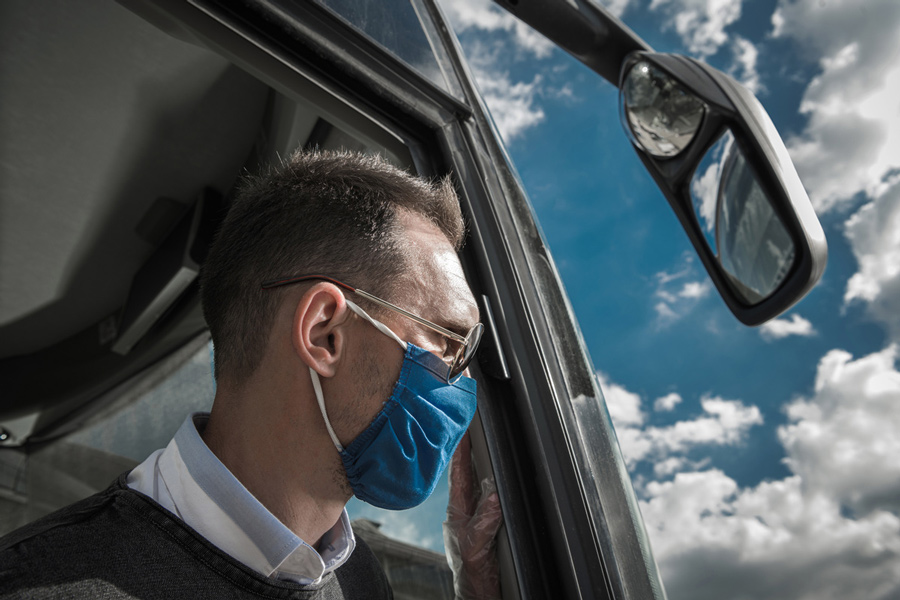By Bob Crescenzo
The recent uptick in bookings may indicate that the pandemic is finally loosening its grip. Before fueling up vehicles and putting anyone behind the wheel, however, there are several matters you should consider to help ensure your company’s safe and successful transition back to the road.
Hiring and Rehiring Drivers
Start by examining your current business strategies and any operational changes, even subtle ones, since the pandemic shutdown to determine whether everyone is returning to their previous positions. If you furloughed or laid off drivers during the pandemic, you may learn that some have found new jobs or don’t want to return because they have concerns about being exposed to the virus, even if you’ve taken the necessary safety precautions.
 You may also notice that as the demand for transportation services increases, the pool of available candidates decreases. While the commercial transportation industry had already been experiencing a shortage of drivers for quite some time, the events of the past year have further complicated matters. Many older drivers retired and new ones couldn’t get their training because of the pandemic, and turned to other career opportunities. Furthermore, a significant number of CDL holders were pulled off the road by the Federal Motor Carrier Safety Administration’s Drug and Alcohol Clearinghouse due to failed drug tests.
You may also notice that as the demand for transportation services increases, the pool of available candidates decreases. While the commercial transportation industry had already been experiencing a shortage of drivers for quite some time, the events of the past year have further complicated matters. Many older drivers retired and new ones couldn’t get their training because of the pandemic, and turned to other career opportunities. Furthermore, a significant number of CDL holders were pulled off the road by the Federal Motor Carrier Safety Administration’s Drug and Alcohol Clearinghouse due to failed drug tests.
Despite these challenges, don’t take shortcuts when it comes to hiring. Selecting the wrong drivers can lead to a variety of problems, including tragic accidents, costly lawsuits, and stiff fines and penalties—all of which can jeopardize your company’s future. Maintain strong, regulatory-compliant, and consistent hiring standards and requirements to help ensure you have knowledgeable and qualified individuals driving your fleet. Importantly, make sure that any employees who are involved in the hiring of drivers are properly trained in your company’s procedures and that all guidelines are being strictly followed.
“... assume that every driver is a new driver. That means making sure records such as, but not limited to, licenses, medical certifications, motor vehicle records, drug and alcohol testing, and Clearinghouse queries are up to date.”Once you have determined who’ll be behind the wheel of your vehicles, assume that every driver is a new driver. That means making sure records such as, but not limited to, licenses, medical certifications, motor vehicle records, drug and alcohol testing, and Clearinghouse queries are up to date. Keep in mind that some laws may have changed since your vehicles were last on the road (e.g., new CDL requirements for New York stretch limousine drivers), and it’s up to you to make certain that your company abides by the regulations. If drivers were furloughed and haven’t driven professionally since that time, you’ll need to account for the time gap from a compliance point of view. To be thorough, interview all returning chauffeurs to ascertain whether they drove for any other company(ies) during the pandemic. If necessary, obtain their previous seven-day hours of service information before scheduling any trips.
Mental Health Challenges
When speaking to your drivers, it would also be a good time to discuss their feelings about getting back to work. Some may feel excited at the prospect of returning to some level of normalcy, yet others may experience stress and anxiety about interacting with passengers while COVID cases still linger. Recognize that every person has had a different experience in regards to the pandemic, so each one is likely to react differently. In fact, you need to be mindful of the mental health challenges that may accompany the return-to-work transition for all employees.
 To help personnel feel less apprehensive about returning, communicate, communicate, communicate. This includes informing everyone about the procedures and precautions you’ve established to help ensure employees are coming to work healthy and working conditions are safe. Keep in touch with your staff frequently, particularly in the first few weeks after coming back, to see what is functioning well and what isn’t, and to gauge how employees are doing and feeling. Recognize the signs of stress (e.g., frustration, irritability, lost sense of humor, difficulty concentrating), and look for behavioral cues, such as changes in attitude, personality, and appearance or decreased productivity, which could indicate that someone may be struggling. Remain receptive to employee concerns and suggestions, and be prepared to address them. People feel more secure when they are informed and assured that they are a valued member of the team. (Visit the Centers for Disease Control and Prevention website cdc.gov for more information on stress and coping during the pandemic.)
To help personnel feel less apprehensive about returning, communicate, communicate, communicate. This includes informing everyone about the procedures and precautions you’ve established to help ensure employees are coming to work healthy and working conditions are safe. Keep in touch with your staff frequently, particularly in the first few weeks after coming back, to see what is functioning well and what isn’t, and to gauge how employees are doing and feeling. Recognize the signs of stress (e.g., frustration, irritability, lost sense of humor, difficulty concentrating), and look for behavioral cues, such as changes in attitude, personality, and appearance or decreased productivity, which could indicate that someone may be struggling. Remain receptive to employee concerns and suggestions, and be prepared to address them. People feel more secure when they are informed and assured that they are a valued member of the team. (Visit the Centers for Disease Control and Prevention website cdc.gov for more information on stress and coping during the pandemic.) The Need for Driver Training
Another matter that should be considered as you transition back to business is driver training. Transportation experts acknowledge that when drivers are inactive for an extended period of time, their driving skills, proficiency, and situational awareness deteriorate. That’s why any chauffeurs who have been sitting idle because of the pandemic will benefit from regulatory-compliant training refreshers.
Start with a road test to check for acuity, decision-making, and agility. Confirm that each driver is comfortable with all of the technology in the type of vehicle(s) they will be driving (e.g., adaptive cruise control, lane assist, and blind spot warning systems), and they know how to use company electronic logging devices (ELDs), cameras, and telematic hardware and software without any issues. Be sure drivers understand their responsibilities in regards to COVID hygiene, social distancing precautions, personal protective equipment, and vehicle cleaning processes, as we may be getting lax as the virus numbers decrease. Review all procedures for drop-offs, parking, pickups, and managing passengers, particularly if your company has updated any operational practices, diversified, or taken on different customers since the shutdown.
Of course, if you’re graduating current chauffeurs from one vehicle size to another (generally smaller to larger); bringing on new, inexperienced drivers; or even hiring individuals with previous driving experience in the types of vehicles in your fleet, it takes a lot more than just handing them the keys and saying “be safe out there.” It involves a driver training program that is in compliance with safety regulations and requirements, tailored to the current operational needs and exposures of your organization and covers at a minimum:
• Risk and accident scene management
• On-the-road driving experience and specialized training for vehicle types/routes
• Defensive driving
• Productivity and driver expectations
• Customer management and service
• Regulations and standards
• COVID policies and procedures
You will also need to further refine these components by identifying specific driving and passenger management skills related to each type of vehicle you operate. However, education should not stop there. A good driver training program includes ongoing, refresher, and even remedial training to help remind all drivers of their responsibilities in operating vehicles safely, and encourage them to make the right choices behind the wheel.
There’s no doubt that the past year has been profoundly challenging for every passenger transportation company, and it’s certainly understandable that you are eager to get your vehicles back on the road. But the new realities stemming from the COVID crisis underscore the importance of strong hiring standards, communication, and ongoing driver education. By selecting your employees carefully, and providing them with the information and training they need, you can rest assured they are better prepared to help transition safely and successfully to transporting passengers out on the nation’s roadways once again. [CD0421]
Bob Crescenzo is the Vice President for safety & loss control of Lancer Insurance Company in Long Beach, N.Y. He can be reached at bcrescenzo@lancerinsurance.com.

